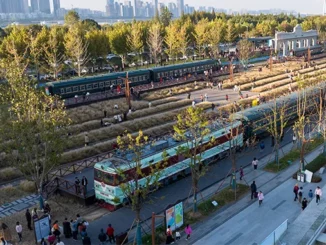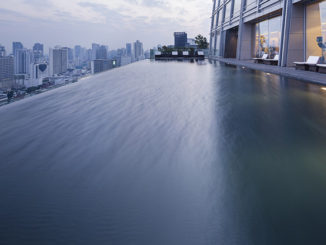
For centuries, Huangshi Bay’s unique natural setting has made it an ideal and significant marine habitat and fishery in China. However, over the past 40 years, the uncontrolled growth of aquaculture industries has completely transformed the shoreline, resulting in public inaccessibility and irreversible ecological degradation. Located along China’s east coast, the Huangshi Bay shoreline is now susceptible to various natural disasters, with rising sea levels further weakening the site’s coastal resilience.
Adjoining the Yellow Sea in northern China, the Huangshi Bay shoreline is primarily composed of cliffs and beaches. The confluence of ocean currents introduces abundant bait and mild water temperatures year round, making it an ideal habitat for marine life and migratory birds. These optimal natural conditions have supported the fishing industry and shaped the spatial and spiritual characteristics of the region for generations.

To improve the site’s resilience and celebrate its rich fishing heritage, Sasaki’s master plan for a 981-acre coastal park integrates the restoration of marine ecosystems with an upgrade of aquaculture industries and introducing recreational programs into a multi-layered system. Protecting the site against environmental risks while ensuring cultural and economic success, the plan positions Huangshi Bay Coastal Park as an innovative model for coastal rehabilitation in China.
Design towards Sustainability
In recent years, rising sea levels caused by global warming have received close attention around the world and posed a great challenge for coastal infrastructure. China’s east coast, where the site is located, is only around 6-16 feet above sea level, making it susceptible to storm surges, coastal erosion, and flooding. Rising sea levels, along with extensive land reclamation that resulted in losses of wetlands and mudflats, will further weaken its coastal resilience.

Engineered “hard” systems, such as seawalls and sea ponds, negatively affect coastal ecosystems and require substantial financial and human resources to maintain. In contrast, “soft” coastal protection systems built upon ecological engineering are more sustainable and cost-effective but have not yet been widely adopted in China.
The latest plan for urban development and marine nursery industry upgrades in the region offers opportunities for coastal rehabilitation in the bay. The coastal park at the 988-acre site will be a pilot project in reimagining the seashore. Comprising of a continuous trail system and a composite ecological protection system, the project aims to leverage the rich natural and cultural assets and rehabilitate the site from ecological, economic, and social perspectives.
A Natural Coast
The design proposes a rehabilitation of the natural shoreline ecosystem to improve the site’s resilience against natural disasters and mitigate climate change.

The small-scale existing woodland will be enhanced into a mixed shelterbelt forest, with multiple species planted for coastal protection and carbon sequestration. Nitrogen-fixing plants will be introduced to improve the soil quality. Existing structures on site, including fish tanks and fishponds, will be conserved and transformed into site features, and materials from demolition of existing buildings will be reused as sub-base for paving to limit the embedded carbon of the project.


Based on the specific conditions of each shoreline segment, a variety of measures will be employed to increase flexibility and resilience against heavy storms and rising sea levels:
1. Along the sandy shoreline, restore the beach-dune-shelterbelt forest section as a multi-layered protection system, which also offers diverse habitats and helps conserve endangered species, including psammophytes;
2. Along the rocky coastline, build oyster reefs along the parameter of the existing fish ponds to help resist erosion and convert fishponds to tidal habitats for a variety of marine life;
3. In the estuary tidal flats, restore seagrass beds to reduce wave energy and construct wetlands nearby to purify tail water from nurseries.
A Productive Coast
The design endeavors to upgrade the aquaculture industry through reorganizing and centralizing nursery buildings while creating innovative nursery production models. To take advantage of the site’s unique natural assets and retain the fishermen’s sentimental connections with the sea while minimizing environmental and visual impacts to the shoreline, three compounding models are introduced to ensure that efficient and environmentally friendly marine nurseries thrive on site:



1. Attach public programs to nurseries by merging the outward urban interfaces of multiple public functions with inward production modules;
2. Integrate with existing terrain by laying the production modules for species that live on the ocean bottom on lower levels, and hotel or commercial uses on upper levels, with completely separate circulation to allow for efficient land use without interference between uses;
3. Encase nurseries in sand dunes for species with the least demand for sunlight – this will not only allow them to operate in close vicinity to the sea without interfering with the dune landscape or habitats, but also help reduce the amount of sand needed and stabilize the dunes.
A Lively Coast
Preserving the coast’s history and cultural heritage is crucial in maintaining the essence of the place. The design repurposes spaces once occupied by production facilities, serving as a reminder of the fishing community’s past while attracting people to the waterfront.

The proposed trail system, with diverse public destinations and programs that cater to all groups during all seasons, will allow ample access to the sea, provide an enriched coastal experience, and serve local communities and visitors to the region. Different itineraries connecting various destinations will enable visitors to experience the ecological, cultural, and industrial assets of the site.

Some existing structures will be adapted for public uses, recalling the fishing community’s seafront life. The design proposes renovating five existing piers and transforming them into coastal hubs that host seaside bars and other recreational facilities. Existing fishponds will be reused and reprogrammed as mirror ponds with various programs to celebrate the site’s aquaculture history and embrace new possibilities. To activate the seafront, sea-combing, enabled by ecological restoration, will also be brought back at several spots.

A Paradigm for Aquaculture Coastal Renewal
Extensive sea reclamations have made China the world’s largest aquaculture producer since the 1990s. While economically beneficial, the intense exploitation of fishery resources and seafront life has created irreversible impacts on the environment and local culture.
The Huangshi Bay Coastal Park Master Plan is a pioneering effort in creating a new model of working seafronts that combines ecology, production, and leisure. Its attempt in mitigating the conflict between industry and nature creates a sustainable paradigm for coastal rehabilitation in China.
Huangshi Bay Masterplan
Designer Credit: Sasaki Associates, Inc. 善启设计咨询(上海)有限公司
Client: Yantai Huang-Bohai Sea New Area Natural Resources and Planning Bureau
Collaborators/Other Consultants:
Yantai Economic and Technological Development Area Ocean Economic Development Bureau
Ocean University of China College of Marine Life Sciences



